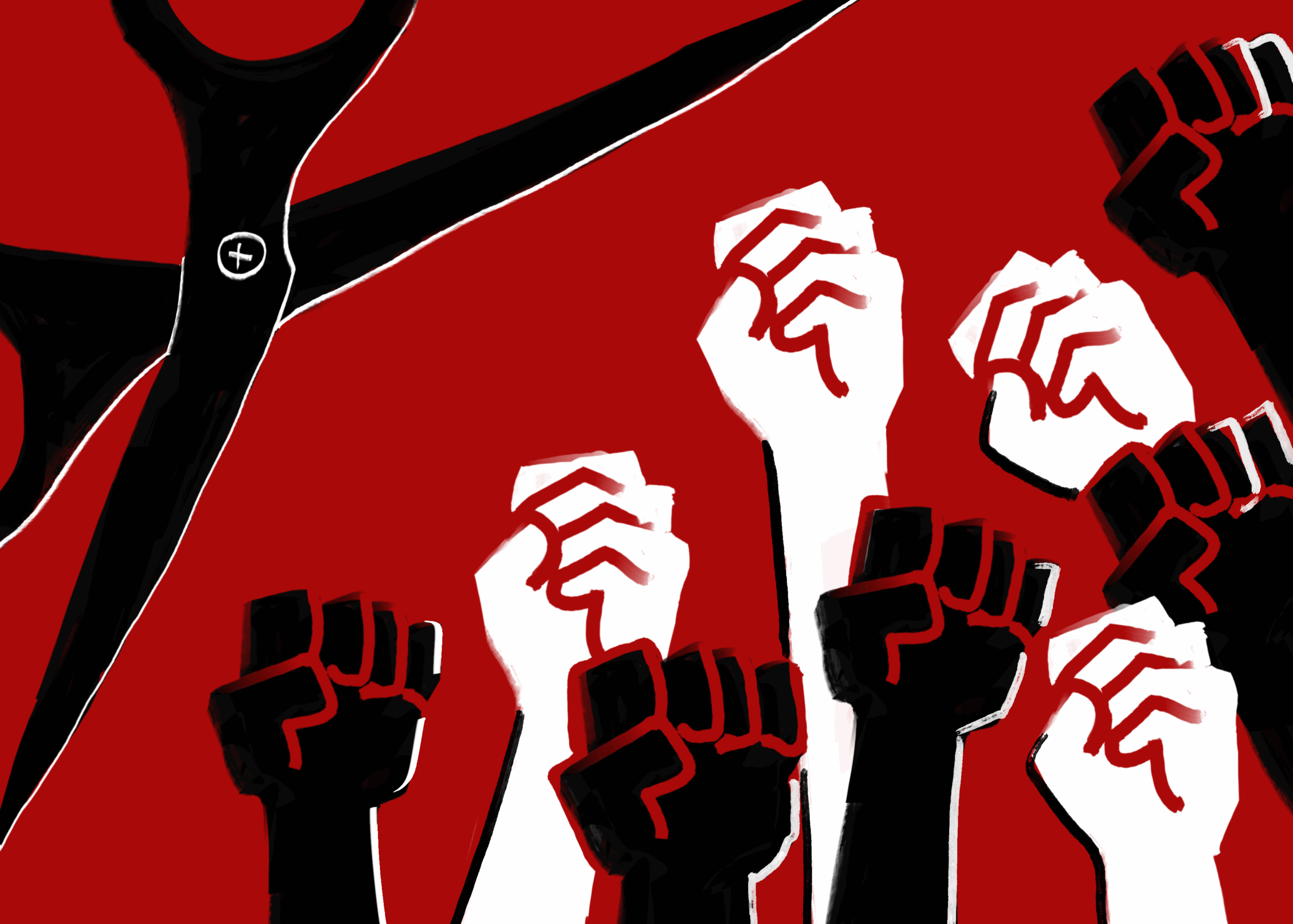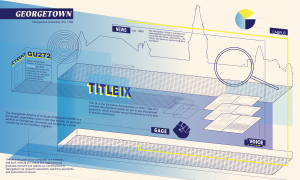University plans to change the benefits of Georgetown University Transportation Shuttle (GUTS) bus drivers have put unions and labor organizing at the center of student attention.
Georgetown University announced in July that it would hire an external management company, Abe’s Transportation, to assume responsibility for GUTS drivers, making them no longer University employees. The takeover could reduce drivers’ employee benefits, such as healthcare and retirement, according to The Hoya. The decision sparked resistance from concerned community members, including petitions and protests.
The GUTS campaign brought awareness to unions on campus, said Fiona Naughton (SFS ’26), a board member of the steering committee for the Georgetown Coalition for Workers’ Rights (GCWR). She said that for many in the Georgetown community, the campaign has served as a wake-up call.
“People are coming face-to-face for the first time with the fact that Georgetown would threaten the jobs of people who’ve been with the university for over 15 years,” Naughton said.
The university wrote that its “difficult decisions to limit spending and look for operational efficiencies” were an effort to limit spending in response to “unprecedented threats to its financial model.”
On Oct. 23, the Georgetown Advisory Committee on Business Practice passed a non-binding resolution to Chief Operating Officer David Green recommending that all 18 GUTS drivers remain permanent employees of the university.
GUTS drivers are part of the Service Employees International Union (SEIU) Local 1199 chapter, a union established in 1972 to protect the rights and compensation of facilities, dining, and transportation workers.
This is just one of five unions representing workers on Georgetown’s campus. Yet, Naughton said that there is a barrier between workers and undergraduate students, who are often less familiar with the functions, histories, and social dynamics of unions.
“The role of our organization is to amplify the struggles that workers are going through on campus to the student body,” Naughton said, referencing GCWR. “A lot of students at Georgetown don’t want to acknowledge the labor around them and how many people work to sustain their lives.”
Georgetown is more than just an institution of higher learning, Naughton said. It’s the largest private sector employer in Washington, DC, employing more than 5,000 people.
“Georgetown is a business, and they have economic interests first and foremost,” Naughton said.
Union chapters
Most on-campus unions are chapters of larger national organizations. Members pay dues to be part of the union and receive benefits, such as having union representatives who advocate for workers’ demands to their employers and help them with contract renegotiations.
Lane Windham is the Associate Director of the Kalmanovitz Initiative for Labor and the Working Poor, a labor center at Georgetown that organizes projects, discussions, and research to build an equitable economy. Windham said that the vocal presence of unions on college campuses developed in the 1970s.
“In the ’70s, a lot of public sector universities started to form unions, and also in the private sector,” Windham said. “Frankly, we saw a lot of the universities fight those workers’ efforts.”
Chapter 1199SEIU was the first union established at Georgetown in 1972. It has represented Georgetown’s facilities and maintenance employees for decades, a university spokesperson said.
Several other unions have since been established to meet the demands of on-campus workers, including adjunct faculty and student employees, such as the Georgetown Resident Assistance Coalition (GRAC).
Undergraduate efforts
Despite the presence of unions, Naughton said that students remain largely unaware of the impact that on-campus unions can have.
GRAC, a union made up entirely of undergraduate students that advocates for on-campus Resident Assistants (RAs), began to change this division.
In May 2025, GRAC negotiated a contract that gave RAs set working conditions, a year after they successfully unionized. Victoria Allen (CAS ’27), a member of GRAC and an RA in Hayden Hall, said that before GRAC, if an RA’s employment began on Aug. 10, they could be fired on Aug. 11 without forewarning or justification. Since RAs receive free on-campus housing and meals, this has long-term implications for students who would have to adjust their accommodations.
“To come up with another $25,000 in three days is kind of preposterous for anybody to do,” Allen said, referring to the estimated cost of housing, meal subsidies, and annual RA salary.
Before the union negotiated a contract, RAs received no direct financial compensation.
“High fives and pats on the back do not equate to actual money for a job,” Allen said.
Now RAs get paid $1,750 a semester—or about $125 biweekly.
The power imbalance between students and their community directors, whom RAs directly report to, has also improved due to the union, according to Allen.
“How they treated their previous RAs was you get told what to do,” Allen said. “But now we actually have a process of how to do things.”
Challenges unions face
Rachel Milito (SFS ’12, GRAD ’27), the president of Georgetown Alliance of Graduate Employees (GAGE), said they’ve seen both benefits and hurdles in their unionization efforts.
Many master’s and PhD students in the union do not have full-time jobs and rely on their teaching salaries to sustain themselves. The current pay rate for PhD students is $23.34 an hour or $39,924 a year. While this is on par with the national average, Milito said it is less than what is considered a living wage in D.C.: $25.98 an hour for a single, childless adult.
“The number of people who are one paycheck away from being in credit card debt, or from not being able to pay their rent, or for their utilities, or for food for their families is considerable,” Milito said.
GAGE aims to negotiate contracts that increase the wages of graduate students. During their most recent contract negotiation two years ago, the union negotiated about a 10% increase from the university’s initial contractual offerings after about six months of financial negotiations, according to Milito.
The university told the Voice that they do not comment on contract negotiation processes.
Unions like GRAC and GAGE have enabled students to consolidate negotiating power, union members said. Still, Allen said that they have struggled to change the Georgetown administration’s perception, particularly because GRAC is composed entirely of undergraduate students.
“I think from the university side, they would say that they see us as legitimate, but from my personal perspective, I feel they see us more like a club than a legalized union with protection,” Allen said.
The university wrote to the Voice that it was grateful to the unions and their role in the community.
“We deeply appreciate the contributions that University faculty, staff, student employees, and contracted workers make to the Georgetown community,” a university spokesperson wrote. “We are also grateful for the leadership and collaboration shown by each of the unions representing workers at Georgetown.”
Language and other barriers
The challenges of union organizing, at Georgetown and across the country, get even more complicated with language barriers, as unions bring together workers of different backgrounds.
Historically, minority workers have made up the largest share of unionized workers in the U.S. As Latino immigration has increased recently, a growing number of union workers are Hispanic. Windham said that this change has created linguistic differences that can create tensions and a division of interests among union members.
“We live in a society where racism and linguistic hierarchy exist, and so it’s going to be replicated in unions in the same way,” Naughton said.
Because unions draw their power from their solidarity, when social tension creates divisions within the union between old and new members, a union can lose its power, Naughton said.
Additionally, the union representative does not necessarily work for the employer and instead can be outsourced by the larger chapter, which is the case with Georgetown’s dining and facilities union, SEIU1199.
When union representatives are not workers, they may not fully understand the situation or demands union members are fighting for, according to Naughton.
“It becomes a source of extreme frustration for workers, and they feel as though [the union] doesn’t actually represent their interests and is actually making things harder,” Naughton said. For example, the representative for the facilities union is not a facilities worker, making him “very divorced from the workers himself.”
Student awareness
While some unions have struggled to represent the needs of their workers, student organizers are facing misconceptions about unionization within the campus community. Allen notes that the RA union is not just fighting RA benefits; it is also setting a precedent to follow and improve upon. She said that joining a union has made her realize the stigmas that come with unionized labor, including among the student body.
“There’s a lot of misconceptions, like unions just want the money or they’re hurting corporations or companies,” Allen said. “Or we just hate our bosses.”
Allen said that unions act with the intention to improve a workplace and protect workers, rather than to be hostile to management.
Naughton said that students should want to care for the workers who make college life possible. Students hold special bargaining power with Georgetown since they pay tuition, according to Naughton. Unlike workers who are employees and may be scared to speak out, students directly fund the university. She believes this grants students some leverage with the university as they are paying stakeholders investing in Georgetown’s services.
“This is affecting every aspect of university life on campus,” Naughton said. “It’s just a fundamental human obligation to care about the concerns of your community members, and as students, we occupy such a privileged position on campus to be able to study and to work.”
However, even for self-interested reasons, she said that undergraduate students should be aware of unions because at some point in life, every student is or will be a worker.
Ultimately, understanding unions can begin with a simple conversation, according to Naughton.
“Try to understand how they would describe their work, what it means to them, how long they’ve been with the university, and what unique challenges they’re facing,” Naughton said.
For Milito, the importance of unions goes back to Georgetown’s Jesuit values, which focus on caring for the needs of each person. She said that the community on campus includes the workers who keep campus running and that students “are not separate from others.”
“Do I also care about the person who is cleaning my dorm bathroom or about the person who is teaching my 8 a.m. discussion section?” Milito said. “Because that is what a complete community is.”
Editor’s note: This article has been updated to correct the graduate student worker pay rate and Milito’s graduation year.





